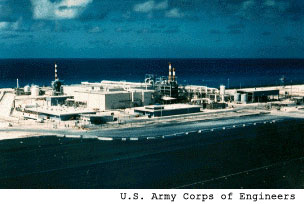Johnston Atoll Chemical Agent Disposal System (JACADS)
Note: EPA no longer updates this information, but it may be useful as a reference or resource.
| Johnston Atoll Chemical Agent Disposal System Quick Finder | ||||
Permit History
JACADS' environmental safeguards, including closure and cleanup procedures, are governed by an EPA permit under the federal hazardous waste law, RCRA (Resource Conservation and Recovery Act). In August 1985, EPA issued a ten-year permit to the Army to construct and operate JACADS and its weapons storage facility. Chemical weapon processing began in June, 1990.
On July 15, 1997, EPA proposed to issue the Army a new permit that would cover more aspects of JACADS than the original permit. The Army submitted almost 500 comments to EPA on the proposed permit.
After reviewing public comments on the proposal, EPA issued the new, stricter hazardous waste storage and treatment permit on June 11, 1998. The Army appealed. By the end of 1998, EPA and the Army negotiated a settlement that resulted in the Army withdrawing its appeal.

The new permit conditions included changes to the deactivation furnace pressure; clarification of how certain federal regulations to prevent organic emissions affect JACADS; a revised sampling plan for spent carbon; and changes to the Venturi scrubber brine flow rate and differential pressure.
Throughout the nearly 20 year (1985 to present) period of the JACADS permit, there were hundreds of permit modifications approved to ensure the safe operation of this facility.
Closure and cleanup
Now that the weapons destruction is complete, the Army has cleaned up the site and decommissioned JACADS. The permit required that the facility be dismantled and that the Army clean up any remaining contamination. Cleanup, dismantling and demolition took about three years, from May 2001 to November 2003.
On January 2, 2001, EPA announced minor changes to the permit to let the Army continue monitoring air emissions from the incinerators' smokestack while burning wastes that are created from the facility's dismantling and cleanup. The Army will use automatic and continuously operating air monitoring instruments to measure stack emissions.
In July 2000, the Army sent EPA a request to change the existing Closure Plan. Due to extensive comments from EPA and the public, the Army revised its JACADS Closure Plan as announced through a public notice in November, 2001. The Army held its most recent public meeting regarding the Closure Plan in Honolulu on December, 11, 2001. EPA received comments from the public on the revised Closure Plan in a comment period that ended February 28, 2002.
- Public Notice of Modified Permit (690 K PDF)
If you are not familiar with PDF, please read about PDF files.
In April of 2001, EPA partially approved the Closure Plan allowing treatment of closure waste by incineration only. At the time other treatment methods and the Human Health and Ecological Risk Assessment (HHERA) work plan, the Sampling and Analysis Plan (SAP) and the quality Assurance Project Plan (QAPP) were under development and not complete.
In September, 2002, EPA approved the Revised Closure Plan, which will allow the U.S. Army to begin cleanup of the facility.
In September, 2003, the Army completed the remainder of the environmental sampling. In the spring of 2004, EPA expects to receive the certification showing that the JACADS facility has been clean closed.
and the U.S. Army Corps of Engineers
![[logo] US EPA](../gif/logo_epaseal.gif)